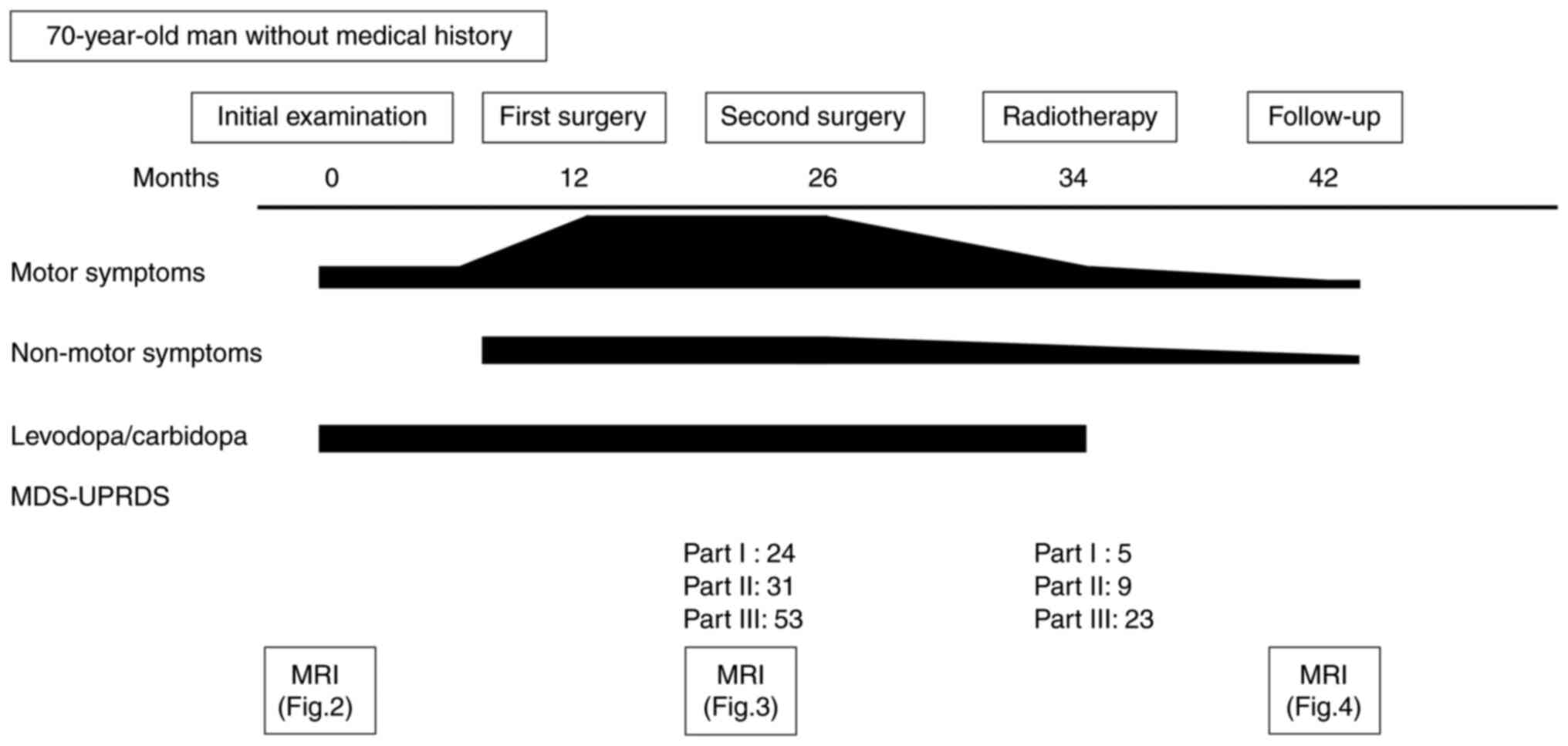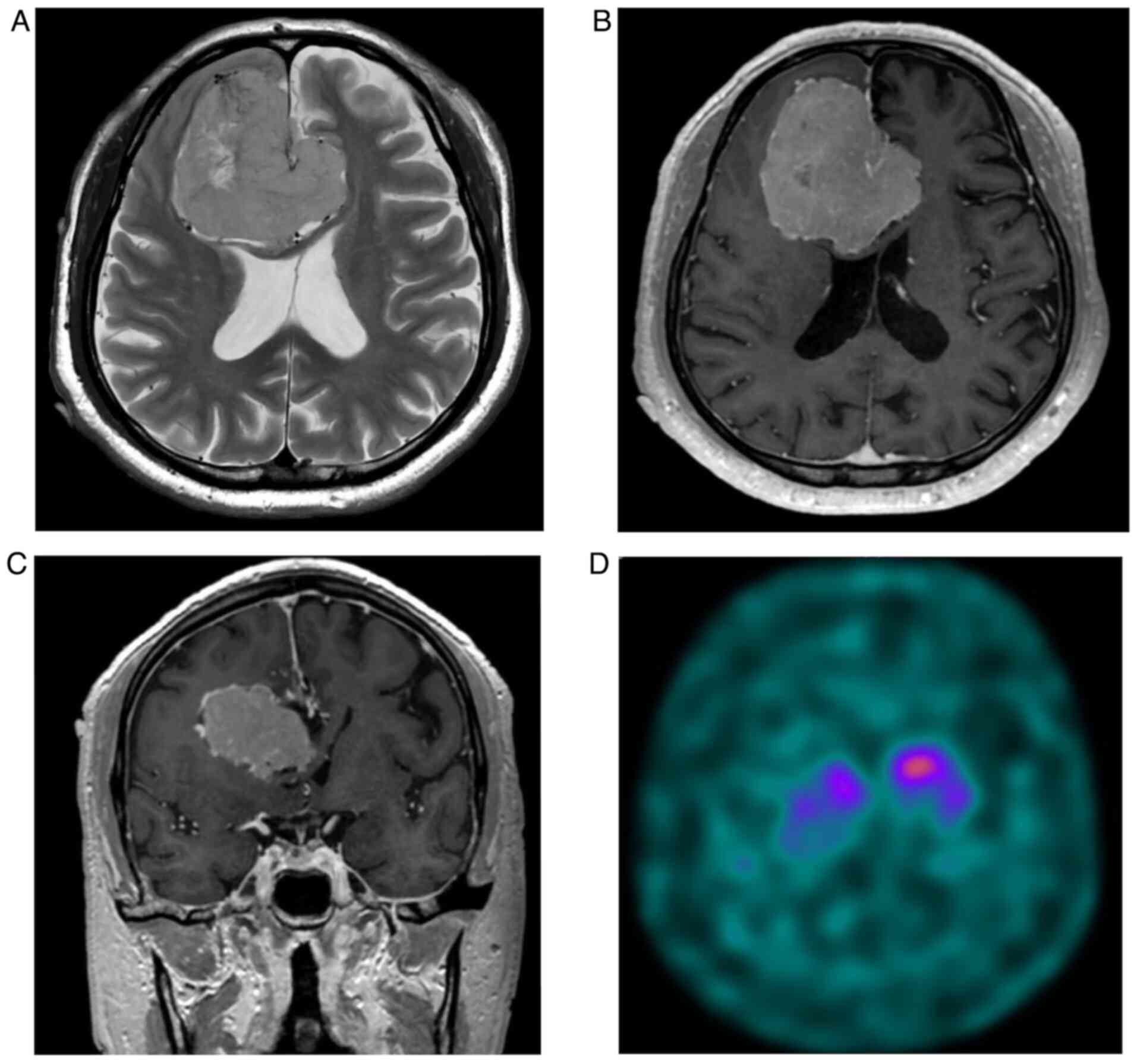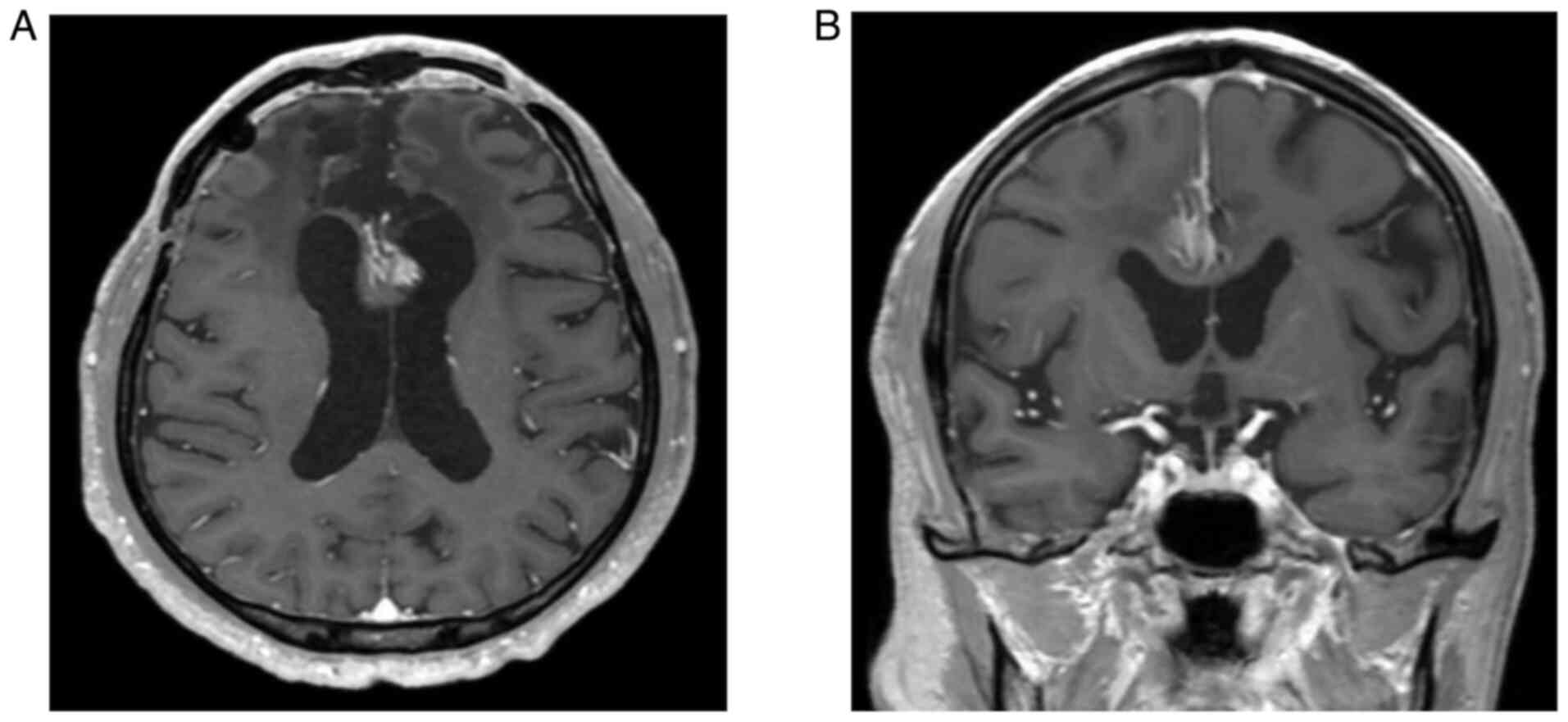Meningioma‑associated parkinsonism related to basal ganglia and cerebellar motor circuits: A case report and literature review
- Authors:
- Shintaro Takeda
- Shohei Nagasaka
- Kohei Suzuki
- Koichiro Futatsuya
- Junkoh Yamamoto
-
View Affiliations
Affiliations: Department of Neurosurgery, University of Occupational and Environmental Health, Kitakyushu, Fukuoka 807‑8555, Japan, Department of Radiology, University of Occupational and Environmental Health, Kitakyushu, Fukuoka 807‑8555, Japan
- Published online on: October 9, 2024 https://doi.org/10.3892/etm.2024.12742
-
Article Number:
452
Metrics:
Total
Views: 0 (Spandidos Publications: | PMC Statistics:
)
Metrics:
Total PDF Downloads: 0 (Spandidos Publications: | PMC Statistics:
)
This article is mentioned in:
Abstract
Parkinsonism can be caused by a variety of factors, such as drugs, vascular disease, toxicity, infection, and autoimmune, neoplastic, metabolic and functional diseases. Parkinsonism is associated with both motor and nonmotor clinical symptoms. Notably, the accurate diagnosis of Parkinson's disease and parkinsonism remains challenging. Meningioma is the most common type of extraparenchymal brain tumor, which typically presents with headaches, focal symptoms and cranial nerve symptoms. Parkinsonism is a rare initial symptom of meningioma. The present report describes an unusual case of a 70‑year‑old man who presented with tremors, pill‑rolling tremors and left‑sided rigidity. In addition, the patient exhibited asymmetrical bradykinesia (left > right) and mild postural instability. Magnetic resonance imaging (MRI) revealed a homogeneously enhanced cerebral falx meningioma and dilated tortuous veins. Dopamine transporter single‑photon emission computed tomography revealed decreased 123I‑ioflupane uptake in the right striatum. The patient underwent two surgical interventions due to tumor growth and symptom deterioration. Pathological examination revealed transitional meningioma. Postoperatively, the symptoms of the patient improved, and MRI revealed a residual tumor without basal ganglia mechanical compression or venous congestion. It was hypothesized that involuntary movements, including parkinsonism in the present case, were associated with the disruption of the cortico‑cerebellar‑cortical and the dentato‑rubro‑olivary pathways (the Guillain‑Mollaret triangle) due to tumor mechanical compression and venous congestion. Meningioma, which is a type of extraparenchymal tumor, is more likely to cause mechanical compression and venous congestion than the infiltration of the basal ganglia circuit, leading to symptom improvement after surgical removal. This case highlights the importance of considering meningioma as a rare cause of lateral parkinsonism and its potential for symptom improvement after surgical intervention.
View References
|
1
|
Kim J-I, Choi JK, Lee J-W and Hong JY:
Intracranial meningioma-induced parkinsonism. J Lifestyle Med.
4:101–103. 2014.PubMed/NCBI View Article : Google Scholar
|
|
2
|
Hayes MT: Parkinson's disease and
parkinsonism. Am J Med. 132:802–807. 2019.PubMed/NCBI View Article : Google Scholar
|
|
3
|
Tolosa E, Garrido A, Scholz SW and Poewe
W: Challenges in the diagnosis of Parkinson's disease. Lancet
Neurol. 20:385–397. 2021.PubMed/NCBI View Article : Google Scholar
|
|
4
|
Sveinbjornsdottir S: The clinical symptoms
of Parkinson's disease. J Neurochem. 139 (Suppl):318–324.
2016.PubMed/NCBI View Article : Google Scholar
|
|
5
|
Ostrom QT, Price M, Neff C, Cioffi G,
Waite KA, Kruchko C and Barnholtz-Sloan JS: CBTRUS statistical
report: Primary brain and other central nervous system tumors
diagnosed in the United States in 2015-2019. Neuro Oncol. 24
(Suppl):v1–v95. 2022.PubMed/NCBI View Article : Google Scholar
|
|
6
|
Cedergren Weber G, Timpka J, Rydelius A,
Bengzon J and Odin P: Tumoral parkinsonism-Parkinsonism secondary
to brain tumors, paraneoplastic syndromes, intracranial
malformations, or oncological intervention, and the effect of
dopaminergic treatment. Brain Behav. 13(e3151)2023.PubMed/NCBI View Article : Google Scholar
|
|
7
|
Defebvre L and Krystkowiak P: Movement
disorders and stroke. Rev Neurol (Paris). 172:483–487.
2016.PubMed/NCBI View Article : Google Scholar
|
|
8
|
Choi S-M: Movement disorders following
cerebrovascular lesions in cerebellar circuits. J Mov Disord.
9:80–88. 2016.PubMed/NCBI View Article : Google Scholar
|
|
9
|
Krauss JK, Paduch T, Mundinger F and
Seeger W: Parkinsonism and rest tremor secondary to supratentorial
tumours sparing the basal ganglia. Acta Neurochir. 133:22–29.
1995.PubMed/NCBI View Article : Google Scholar
|
|
10
|
Choi K-H, Choi S-M, Nam T-S and Lee M-C:
Astrocytoma in the third ventricle and hypothalamus presenting with
parkinsonism. J Korean Neurosurg Soc. 51:144–146. 2012.PubMed/NCBI View Article : Google Scholar
|
|
11
|
Merrill S, Mauler DJ, Richter KR,
Raghunathan A, Leis JF and Mrugala MM: Parkinsonism as a late
presentation of lymphomatosis cerebri following high-dose
chemotherapy with autologous stem cell transplantation for primary
central nervous system lymphoma. J Neurol. 267:2239–2244.
2020.PubMed/NCBI View Article : Google Scholar
|
|
12
|
Okano R, Suzuki K, Nakano Y and Yamamoto
J: Primary central nervous system lymphoma presenting with
Parkinsonism as an initial manifestation: A case report and
literature review. Mol Clin Oncol. 14(95)2021.PubMed/NCBI View Article : Google Scholar
|
|
13
|
Rodriguez W, Fedorova M and Chand P:
Levodopa-responsive parkinsonian syndrome secondary to a
compressive craniopharyngioma: A case report. Cureus.
15(e35621)2023.PubMed/NCBI View Article : Google Scholar
|
|
14
|
Diyora B, Kukreja S and Sharma A: Cerebral
meningioma presenting as dystonic head tremor. Mov Disord.
29(40)2014.PubMed/NCBI View Article : Google Scholar
|
|
15
|
Kleib AS, Sid'Ahmed E, Salihy SM,
Boukhrissi N, Diagana M and Soumaré O: Hemiparkinsonism secondary
to sphenoid wing meningioma. Neurochirurgie. 62:281–283.
2016.PubMed/NCBI View Article : Google Scholar
|
|
16
|
Fong M, Ghahreman A, Masters L and Huynh
W: Large intracranial meningioma masquerading as Parkinson's
disease. J Neurol Neurosurg Psychiatry. 87(1251)2016.PubMed/NCBI View Article : Google Scholar
|
|
17
|
Labate A, Nisticò R, Cherubini A and
Quattrone A: Midbrain meningioma causing subacute parkinsonism.
Neurol Clin Pract. 8:166–168. 2018.PubMed/NCBI View Article : Google Scholar
|
|
18
|
Al-Janabi WSA, Zaman I and Memon AB:
Secondary parkinsonism due to a large anterior cranial fossa
meningioma. Eur J Case Rep Intern Med. 6(001055)2019.PubMed/NCBI View Article : Google Scholar
|
|
19
|
Inoue H, Yamamura R, Yamada K, Hamasaki T,
Inoue N and Mukasa A: Hemichorea induced by a sphenoid ridge
meningioma. Surg Neurol Int. 12(201)2021.PubMed/NCBI View Article : Google Scholar
|














